reptile
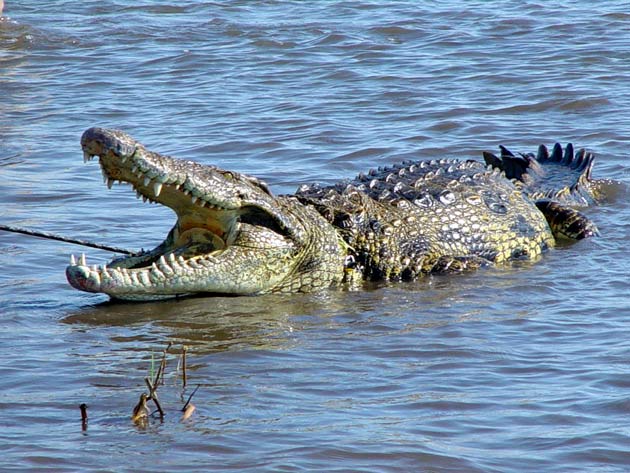
The Nile crocodile, one of the largest of living reptiles.

A reptile evolutionary tree indicates how few species survived from the reptiles' heyday. Crocodiles and alligators are the closest living relations to dinosaurs and also have the most advanced brains and hearts. Turtles and tortoises have changed very little over millions of years; like many areas of reptilian evolution, their origins are obscure. Therapsids, though all species are now extinct, are a vital branch of evolution, for it is from them that the synapsids evolved, which in turn led to the mammals. All, however, evolved from the earliest group of reptiles, the captorhinomorphs, otherwise known as the "stem reptiles."

Figure 1. Some reptiles are well adapted to a life in water, both fresh and salt. Several families of terrapin or turtle are found in lakes and rivers, while all true sea turtles belong to one of two families. The leatherback sea turtle is the only member of the family Dermochelidae; all the remaining sea turtles are placed in the family Chelonidae. The sea turtles possess flippers, but the freshwater species usually have only modified webbed feet.
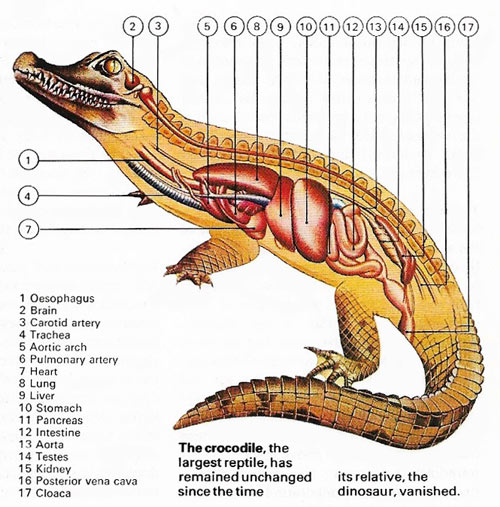
Figure 2. The crocodile, the largest reptile, has remained unchanged since the time its relative, the dinosaur, became extinct.

Figure 3. Flicked out in 1/25th of a second, a chameleon's tongue tip is sticky and partly prehensile, giving the insect victim no chance. In locating food, the eyes swivel independently until prey is sighted, then focus together. Another remarkable characteristic of this reptile is its ability to change color. Color changes are activated largely by changes in light, a signal from the eye passing via the nervous system to pigment cells in the skin. Most chameleons are well adapted for climbing with toes fused and grouped to form grasping hands and feet. The toes have sharp claws.
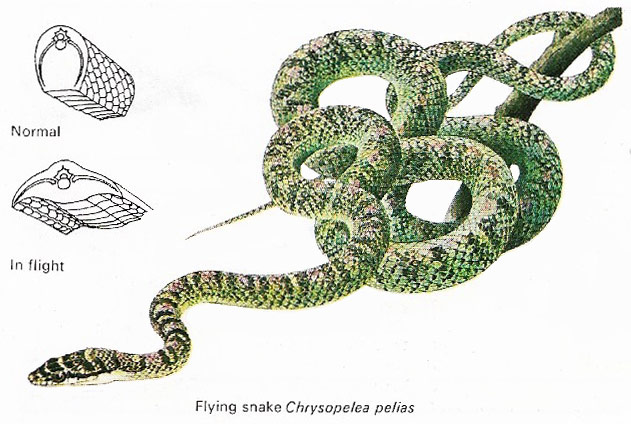
Figure 4. The flying snake glides between trees by flattening its undersurface.
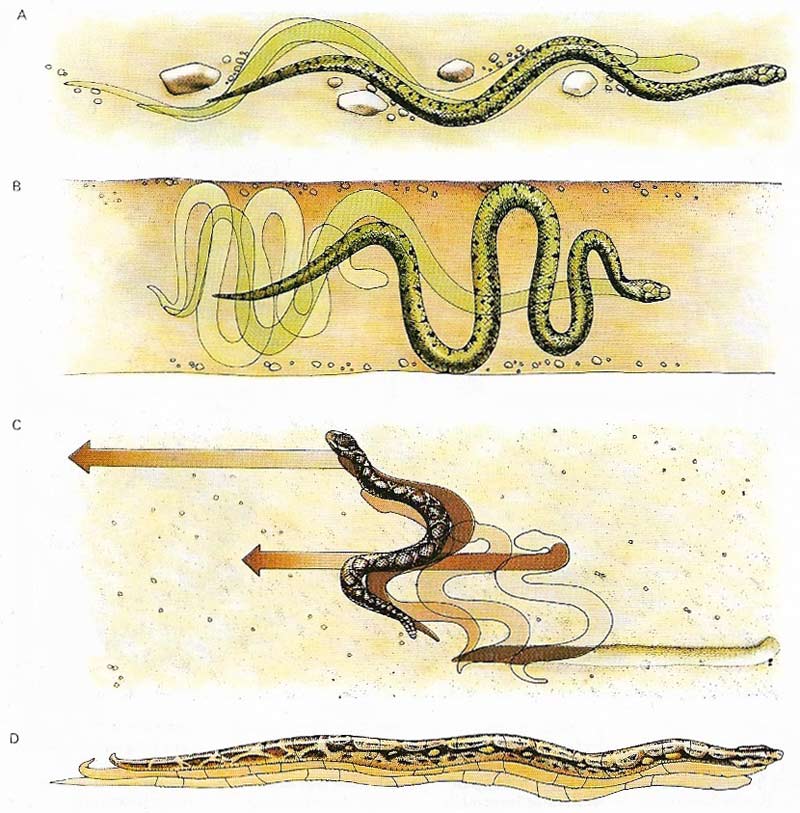
Figure 5. Serpentine locomotion (A) is the conventional means of movement for most snakes on land or in water; in a burrow a snake may use a concertina movement (B). Some desert vipers and rattlesnakes reduce contact with the hot sand by "sidewinding" (C). A boa constrictor moves in a straight line by contraction of its belly muscles (D).
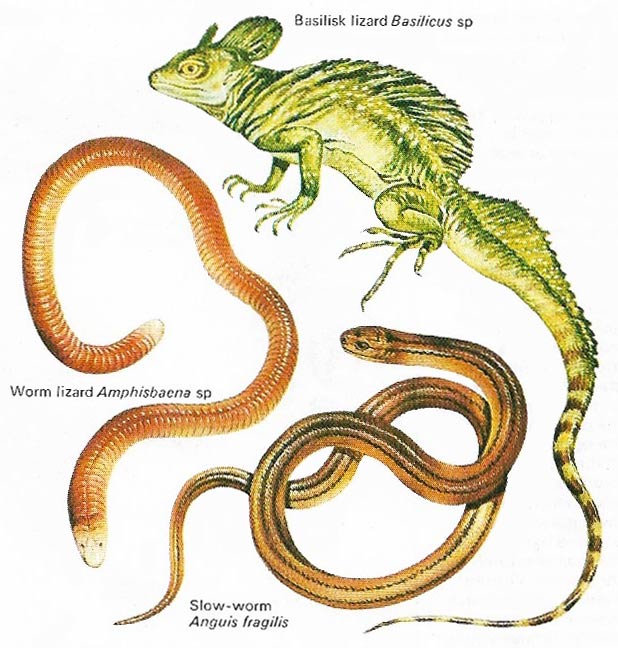
Figure 6. Lizard locomotion shows several variations on the typical four-footed method. Basilisk lizards can run 11 km/h (7 mph) on their hind legs alone. At these speeds the long tail acts as the counter-balancer. Worm lizards are legless burrowers that tunnel by ramming the ground with blunt, strong-skulled heads. In existing tunnels they move like earthworms, pulling their rings of scales forward in groups. The slo -worm belongs to a family of lizards that includes some with normal legs and feet, but like many burrowing or semi-burrowing species this one is limbless.
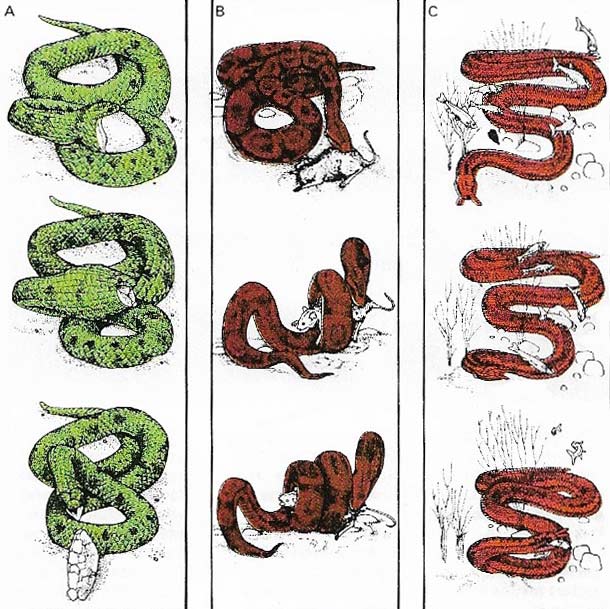
Figure 7. The egg-eating snake (A) gulps eggs, and cracks and rejects the shells. The boa constrictor (B) coils round its prey, suffocating it. The camouflaged fishing snake (C) seizes fish in its back-fanged jaws.
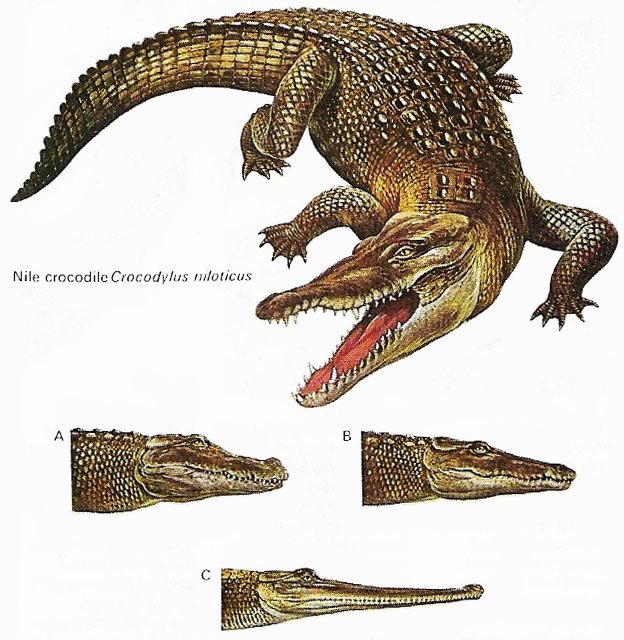
Figure 8. Large alligators (A) and crocodiles (B) are powerful enough to kill and feed on animals up to the size of a cow. The specialized gharial (C) has long, thin jaws which it swings from side to side snapping at fish in the vicinity.
A reptile is an air-breathing, cold-blooded, egg-laying vertebrate with an outer covering of scales or plates and a bony skeleton; it is a member of the class Reptilia. Lizards, crocodiles, tortoises, and snakes are all reptiles. For example, Lacertilla, also called Sauria, is a suborder (order Squamata) of the reptiles that includes the lizards.
Evolution of reptiles
Reptiles, as inhabitants of the Earth, are older than man and all other mammals, and older than the birds. Indeed, early reptilians were the ancestors of both the other classes, and their descendants continue to share with birds such characteristics as the laying of shelled eggs, a single occipital condyle (compared with two in mammals) connecting the base of the skull to the backbone, and a single bone in the middle ear.
Reptiles appeared about 300 million years ago (see early reptiles), descendants of the early amphibians. In the course of time, some grew to huge proportions, like the dinosaurs, but for the past 70 million years they have mostly been small animals, except for the Crocodilia, relations of the dinosaurs.
Reptilian orders
Four main orders of reptile, totalling some 6,000 species, exist today. Tortoises and turtles, of the order Chelonia, are perhaps the most primitive group, with skulls like the early reptiles, the Saurians. The crocodiles and alligators are members of the Crocodilia while snakes and lizards, most recently evolved and most numerous of the reptiles, belong to the order Squamata. The tuatara, sole surviving member of the order Rhynchocephalia, lives in New Zealand and existed as a species 200 million years ago, before the dinosaurs came into existence.
The turtles and terrapins (Figure 1) have shells, typically with a horny layer covering a bony box derived from the backbone and ribs plus bony plates which originate in the skin. It is an effective armor, but heavy. Land tortoises are slow-moving, with legs adapted for weight-bearing; they sometimes have elephantine feet. The most common cheIonian's are terrapins, amphibious freshwater forms with flatter shells than those of land tortoises. Their toes are webbed. Sea turtles are completely aquatic and eat mainly animal food, while land tortoises are largely vegetarian. No species of Chelonia has teeth but deals with its food with horn-rimmed jaws, the front legs assisting in the tearing process.
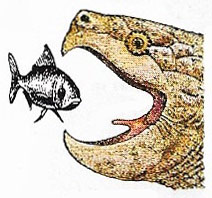 |
| The alligator snapper, Macrochelys sp, has a lure for fish on the back of its tongue – a pink projection that is wriggled like a real worm. Fish are taken in by this bogus bait. |
Crocodiles (Figure 2) and alligators are found in lakes and rivers throughout the tropics, using their muscular, flattened tails for driving themselves through the water and their webbed feet for steering. One species, the estuarine crocodile (Crocodylus porosus), makes its way to the sea. The sharp, conical teeth with which crocodiles and alligators are armed are good for seizing their prey but less efficient at cutting up a carcass; to overcome this drawback the crocodile will spin over in the water with its victim in its grasp, until part of it is torn off. It keeps its sharp bite into old age for it continually grows new teeth to replace the old ones. The alligator differs from the crocodile in its dentition. The large fourth tooth of a crocodile's lower jaw sticks up inside the upper jaw whereas, in the alligator, it disappears into a pit inside the jaw.
Snakes and lizards
Members of the Squamata, the lizards and snakes, share many similarities despite the obvious difference between them (lizards have five-toed limbs, while snakes are legless). Lizards usually have eyelids, visible external ears, and small scales under the belly as well as on the back. Snakes have no true eyelids, no sign of external ears, and possess a single row of large scales along their bellies.
Most lizards are carnivorous, feeding on insects and other small prey, but some larger species, such as monitors, prey upon vertebrates. They tend, like other reptiles, to spend much of the time immobile, waiting for the prey to approach before they grab it, or make a short rush for it (Figure 3). Iguanas and some skinks are among the few vegetarian lizards.
Camouflage and immobility are their main means of defence, but monitors use both claws and teeth to protect themselves and even small lizards may bite if cornered. Others protect themselves by autotomy – if harried they shed part of their tail at a special breaking point, leaving it behind to confuse the predator. A replacement is then grown.
In movement, most lizards have a straddling gait. Many climb and the gecko, which has ridges and microscopic hairs under its toes, can walk on an apparently smooth ceiling. The flying dragon of Southeast Asia is a lizard, which glides using flaps of skin.
Big eaters
Most snakes move by bending their bodies from side to side using muscles along the backbone (Figure 5). The sides of their bodies grip the ground. Some species. However, have adapted to modified means of locomotion.
All are carnivores, swallowing their prey whole. Jaws loosely connected to the skull and to one another permit an enormous gape, and allow prey much wider than the snake's head to be engulfed by "walking" the jaws alternately round it. In this way a 4.8 meters (16 feet) rock python has been known to swallow whole a 59 kilogram (130 pounds) impala, and an 8 meters (26 feet) anaconda a 45 kilograms (100 pounds) peccary.
Large snakes such as these suffocate their victims by construction, squeezing the air out of them. Others – a minority – have poisonous bites. The most dangerous of these are the two families of front-fanged snakes, the cobras, whose venom mainly attacks the nervous system, and vipers and rattlesnakes, whose poison affects the blood and tissues. Venomous snakes, like others, usually flee before a threat, but some use a deterrent display – the cobra spreads its hood, the rattlesnake rattles its tail. The coral snakes have developed garish warning colours, but other non-poisonous species have developed near-identical color patterns as a defence.
Anatomy and other features
Body form and skeleton
Most reptiles have elongated bodies, like those of lizards, crocodiles, and snakes, but the bodies of tortoises and turtles are short and broad. The limbs, when present, are usually short. There are numerous vertebrae: about 60 in crocodiles and as many as 400 in snakes. The head is held off the ground and the neck is more developed than in amphibians, though the plan of the skeleton is similar to that of amphibians. Ribs are well developed between the shoulder and the hip region. Reptiles have more powerful jaws than do amphibians, the lower being made up of several bones. There are usually openings in the temporal region of the skull.
Limbs and digits
The limbs of reptiles (absent in snakes) are jointed and typically five-fingered. Five is the primitive number of digits on the limbs of vertebrate animals, and most reptiles have this number, though crocodiles have only four on their hind feet. The digits are nearly always armed with claws. The limbs of the marine turtle take the form of paddles.
 |
Locomotion
The limbs of most reptiles project on each side of the body, so that the animal does not stand up on its legs but crawls with its belly touching the ground; some lizards, however, run actively on their hind legs. Snakes have no limbs and progress by crawling, and there are also certain lizards, like the slow-worm, which are limbless.
 |
Body covering
Reptiles differ from amphibians in having skin which is usually covered with horny scales or plates.. They may also have bony shields embedded in their skin, as in the crocodiles, and, in more exaggerated form, in tortoises and turtles. Another distinction is that the skin of reptiles, at any rate over most of their bodies, is not glandular, so that it is not moist or slippery like that of a frog. A snake's skin is dry and clean, not slimy as some people believe.
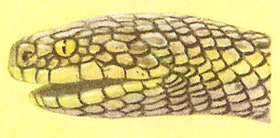 |
Teeth
Tortoises and turtles have sharp, horny edges to their jaws, but no teeth. The teeth of other reptiles are usually sharp and pointed. They are never differentiated into incisors, canines, and molars like the teeth of mammals, but some snakes have hollow fangs, used for injecting poison, as well as ordinary teeth. Reptiles' teeth are used for grasping and tearing, and they swallow food whole or in lumps; it is then dissolved by powerful digestive juices.
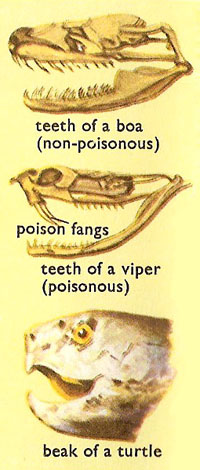 |
Nose and ears
The nostrils of reptiles are situated on each side of their muzzles, and their sense of smell is well developed. Snakes can also be said to "smell with their tongues," as they dart them in and out, collecting scent molecules from the air which are conveyed to a special sense organ in the mouth. The external ear of most reptiles is a simple opening in the head, but this is not present in snakes, which are deaf to ordinary sound.
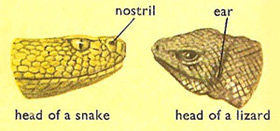 |
Breathing
All reptiles breathe air by means of lungs. Generally they have two lungs, like other land vertebrates. In the more primitive snakes, however, such as pythons, the left lung is reduced in size, while in most other species of snakes it is absent, and only the right lung is developed. This is probably an adaptation to their slender form. The lungs of reptiles are less highly developed, and less efficient than those of birds and mammals.
Circulation of the blood
Most reptiles have hearts divided into three chambers – two atria and one ventricle – and have two systemic arches. This is different from mammals and birds, in which the ventricle is divided so that the heart consists of four chambers; and which have only one systemic arch (the right in birds, the left in mammals).
In the diagram on the right, blood vessels carrying blood charged with oxygen (arterial blood) are colored red, those carrying blood without oxygen (venous blood) are blue. The top diagram shows venous blood coming through two veins into the right atrium, while the left atrium is filled with arterial blood from the lungs. In the ventricle the two kinds of blood become partly mixed. Three arteries leave the ventricle: the pulmonary artery carries venous blood to the lungs; the right systemic arch pure arterial blood; and the left systemic arch mixed blood. These arches join and supply blood to the system; this is not therefore pure arterial blood as it is in the circulation of birds and mammals.
In the crocodiles (lower diagram) the ventricle is divided, but as the left systemic arch still functions, the animal does not gain full advantage from this. But the left arch is narrow, and the two arches are joined by an opening, the foramen of Panizza; this limits mixing of the blood and shows an advance on the normal reptilian pattern.
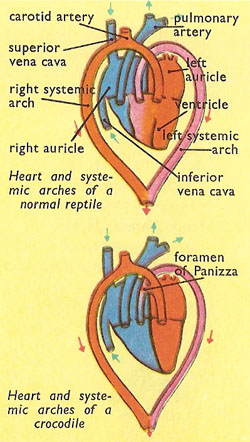 |
Body temperature
The body temperature of reptiles is not kept automatically at a constant (and rather high) level like that of birds and mammals. The blood of a lizard basking in the hot sun gets quite warm, but at night, or on a cold day, it is much cooler. When reptiles are cold they become sluggish, and in temperate climates they cannot remain active in winter, but have to hibernate. For this reason far more kinds of reptiles are found in the tropics than in temperate and cold regions.
Brain
The brains of reptiles are of the same pattern as those of fishes and amphibians, but their fore-brains are considerably larger. It is this part of the brain that in mammals, including humans, becomes convoluted and forms the cerebral hemispheres.
 |
Breeding and birth
Reptiles breed on land and their young grow inside eggs. (In contrast, amphibians have to return to water to breed.) They are either oviparous or ovoviviparous. Oviparous means "egg-laying," and most reptiles reproduce in this way. The covering of their eggs is usually a parchment-like skin, but crocodiles and the lizards called geckos lay eggs within a hard shell.
Viviparous is the word applied to animals that bear their young alive, as mammals do. Some snakes bear living young, but these have developed in the mother's body enclosed in a membrane and nourished by a yolk, just as embryos develop in an egg. Water and oxygen are supplied to the developing young, but their blood circulation is not continuous with the mother's as in mammals. This type of reproduction is called ovoviviparous.
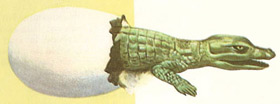 |


